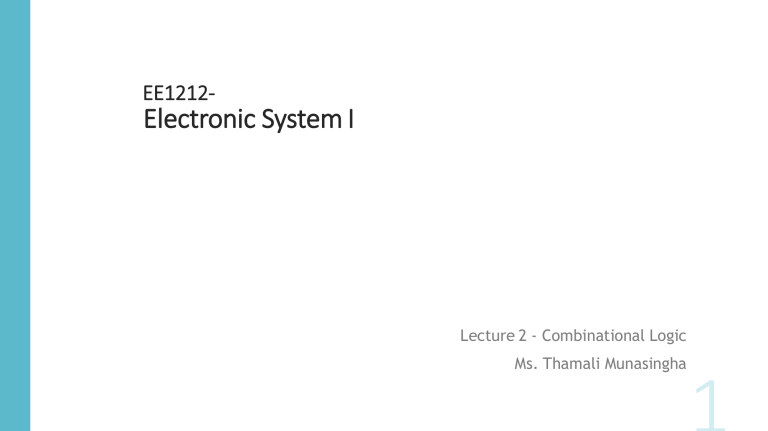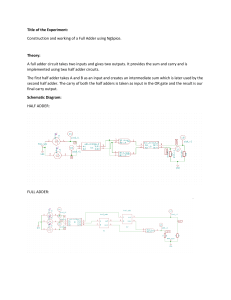
EE1212- Electronic System I Lecture 2 - Combinational Logic Ms. Thamali Munasingha Combinational Circuits • Outputs at any time are determined from present combination of inputs. • Performs an operation that can be specified logically by a set of Boolean functions. • Consists of input variables, logic gates and output variables. • Transforms binary information from the given input data to a required output data. Combinational Circuits n inputs Combinational Circuit m outputs • For n input variables 2n possible input combinations. • For each possible input combination there is one possible output combination. • Combinational circuit can be described by truth table or m number of Boolean functions. Combinational Circuits Combinational circuits such as Adders, Subtractors, Comparators, Decoders, Encoders and Multiplexers are available in integrated circuits such as MSI (Medium Scale Integration) and VLSI. Half Adder • A combinational circuit that performs the addition of two bits is called a half adder. oAdds only single bit nos oDoes not take carry from previous sum • The truth table for the half adder is listed below: S = x’y + xy’ C = xy Implementation of Half-Adder Full-Adder • One that performs the addition of three bits(two significant bits and a previous carry) is a full adder. Simplified Expressions S = x’y’z + x’yz’ + xy’z’ + xyz C = = xy + xz + yz Full Adder implementation Full-adder can also implement with two half adders and one OR gate (Carry LookAhead adder). S=x⊕y⊕z C= (x ⋅ y) + (z ⋅ (x ⊕ y)) Binary adder This is also called Ripple Carry Adder ,because of the construction with full adders are connected in cascade. Carry Propagation • The signals must propagate through the gates before the correct output sum is available in the output terminals. • Total propagation time is equals to: ➢ Propagation delay of a gate x number of gate levels • Carry (Ci) propagation requires the highest amount of time in an full adder. • Si depends on Ci • The signal from the input carry Ci to the output carry Ci+1, propagates through an AND gate and an OR gate. Which consists of two level. Carry Propagation • Assume an adder consists of 4 Full Adders. • The output carry C4 would have 2x4 = 8 gate levels from C0 to C4. • For n-bit adder, there are 2n gate levels for the carry to propagate from input to output. • Outputs will not be correct unless the signals are given enough time to propagate through the gates connected from inputs to outputs. • Solutions for reducing carry propagation delay a. Faster gates with reduced delay b. Increase the circuit complexity – “Carry Lookahead” Carry Lookahead • Increase the equipment complexity in such way the carry delay time is reduced. •Example : Carry Lookahead i – stage in the adder Carry Lookahead 𝑃𝑖 = 𝐴𝑖 ⨁𝐵𝑖 𝐺𝑖 = 𝐴𝑖𝐵𝑖 Then the output sum and carry can be expressed as follows: 𝑆𝑖 = 𝑃𝑖 ⨁𝐶𝑖 𝐶𝑖 + 1 = 𝐺𝑖 + 𝑃𝑖𝐶𝑖 • Gi is called a carry generate and it produces a carry of 1 when both Ai & Bi are 1, regardless of the input carry Ci • Pi is called carry propagate because it is the term associated with the propagation of the carry from Ci to Ci+1 Carry Lookahead • Boolean functions for the carry outputs of each stage. 𝐶0 = 𝑖𝑛𝑝𝑢𝑡 𝑐𝑎𝑟𝑟𝑦 𝐶1 = 𝐺0 + 𝑃0𝐶0 𝐶2 = 𝐺1 + 𝑃1𝐶1 = 𝐺1 + 𝑃1(𝐺0 + 𝑃0𝐶0) = 𝑮𝟏 + 𝑷𝟏𝑮𝟎 + 𝑷𝟏𝑷𝟎𝑪𝟎 𝐶3 = 𝐺2 + 𝑃2𝐶2 = 𝑮𝟐 + 𝑷𝟐𝑮𝟏 + 𝑷𝟐𝑷𝟏𝑮𝟎 + 𝑷𝟐𝑷𝟏𝑷𝟎𝑪𝟎 • Each output carry is expressed in sum of products. • Each function can be implemented with one level of AND gates followed by an OR gate. Carry Lookahead Generator 4-bit Adder with Carry Lookahead



